George Gooderham 1850 - 1906.
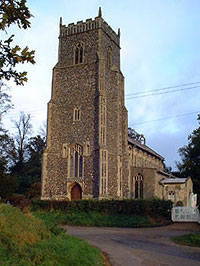
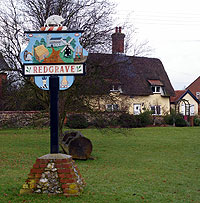 George was my great
grandfather on my mother's side. He seems to have come from a desperately poor
family. His father Robert was born in 1814. (We think he died in 1877, but we
have no real proof). On the 16th October 1818 he was removed with his parents,
Charles & Martha &
his siblings, from Redgrave in Suffolk to Bressingham in Norfolk at the tender age of four, as they were a
drain on the poor laws. All the previous generations had been from Suffolk. Robert's age varies an awful lot on census returns, birth
ranges between 1805 to 1821!
George was my great
grandfather on my mother's side. He seems to have come from a desperately poor
family. His father Robert was born in 1814. (We think he died in 1877, but we
have no real proof). On the 16th October 1818 he was removed with his parents,
Charles & Martha &
his siblings, from Redgrave in Suffolk to Bressingham in Norfolk at the tender age of four, as they were a
drain on the poor laws. All the previous generations had been from Suffolk. Robert's age varies an awful lot on census returns, birth
ranges between 1805 to 1821!
In 1851 Robert is an agricultural labourer with his wife Mary & their four children in Bressingham High Street. We first see George aged 1.
In 1861 Robert was still in the High Street as an agricultural labourer & is noted as being deaf. He had 4 children (Martha his eldest, was a brush maker) and George is now 11. George has no occupation listed, which hints he wasn't in school as a scholar. Robert's mother Martha, was still alive at 80 in Workhouse lane.
In 1871 he is with Mary & two children still in the High St. Bressingham, but George isn't there! Strangely, Robert is no longer noted as being deaf. I found a George Gooderham of approximately the right age, born in Bressington as a platelayer on the railways in Gargrave near Skipton. He looks like he is living with a Duckett family.
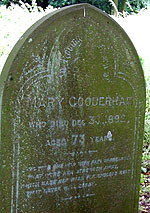 George's
mother, Mary (she was a Holden) was born in 1819. Mary's gravestone, dated 30th. December
1892 (73 years old) is in the churchyard of St John the Baptist in Bressingham,
it reads
George's
mother, Mary (she was a Holden) was born in 1819. Mary's gravestone, dated 30th. December
1892 (73 years old) is in the churchyard of St John the Baptist in Bressingham,
it reads
Long time she was with pain oppressed
that wore her strength away
which made her wish for endless rest
that never will decay.
On the 1851 census her birth place is Wattisfield Suffolk, just below Bressingham & Redgrave. Census returns, once again, varies about her age quite a bit.
The next time we establish contact with George, it is for his marriage to Mary Lund in November 1874, who is resident in Windhill, an area of Bradford. His occupation is a labourer but I suspect he was already working for the new modern way of travel, the railways. My thoughts are that it was a booming industry & he followed it from Norfolk up country to Yorkshire. The first truly successful steam railway was the Liverpool and Manchester Railway (1830). The L&M sparked a feverish boom in railway building that lasted twenty years. By 1854 every town of any size in England was connected by rail, though Wales was less well served. There must have been jobs all over for labourers who worked up from platelayer to Ganger. The term 'platelayer' was the name used in Britain for the men who laid and maintained the "plateways" that were primarily used for coal haulage in the early 19th century. With the coming of the first railroad (a British term) and then railways, the word "platelayer" continued to be used to describe those workers.
In 1881 he is in Downham hall No.1 (next to the
parsonage. Wm Stocks was the curate to Downham) as a general labourer, (with no
mention of the railways) with his first three
children,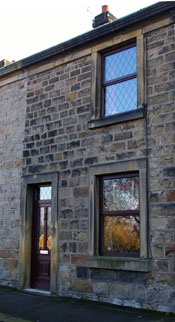 James, Hanna & Eva. At this time in 1881 back in Norfolk, there were three
ancient Gooderham's, all in the workhouse, Family names like Charles (92) George
(91) & another George (72), all classed as pauper agricultural labourers. They
were only a few miles away from where his family were thrown out for being a
drain on the poor laws. By hard work & graft, George was a family man in work &
maybe feeling good about his life.
James, Hanna & Eva. At this time in 1881 back in Norfolk, there were three
ancient Gooderham's, all in the workhouse, Family names like Charles (92) George
(91) & another George (72), all classed as pauper agricultural labourers. They
were only a few miles away from where his family were thrown out for being a
drain on the poor laws. By hard work & graft, George was a family man in work &
maybe feeling good about his life.
In 1891 George & Mary were in 8 Bank Cottages, Billington with 5 kids & his occupation is a platelayer again on the railways (his son Henry is 6 & Nellie, my grandmother is 4). He was employed by the Lancashire & Yorkshire Railways. (Their H.O. was in Manchester & this company became the LMS. in 1923).
In 1901 he is still in 8 Bank Cottages, Billington as a platelayer. Mary & the three children, Eva, Henry & my grandma Nelly, were all working in the cotton mill. It looks like his daughter Hannah was married in the June of 1901 but I can find no trace of her in the 1901 return. Four years earlier, the whole family must have joined in with the huge celebrations of Queen Victoria's Diamond Jubilee that was held in Whalley on the 22nd. June. The family must have been better off than at any time in their lives. To George, it must have seemed a million years from the hardships of Bressingham. His job was secure and with all family members working, his greatest worry must have been affording the marriages of his other two daughters! Two doors down, at number 6, there is the Exton family. Thomas, a 56 year old widower, is a cotton spinner. Lois his daughter with Esther Clough (a cousin, working as a domestic housemaid). His son William, the only other male in the family, is aged 21 and a warehouseman in the cotton mill. At number 10 Bank cottages, it looks like George' other son James, (also a platelayer for the L&Y railway) is married to Martha Ellen (Mercer) & they married in December 1897 & have no children. (There is a Herbert Gooderham, less than one year old, whose death was recorded around March 1898. I have no proof the child was theirs).
In the Clitheroe Times dated January 4th. 1907 came this report:
WHALLEY RAILWAY TRAGEDY.
PLATELAYER KILLED
The Clitheroe district has shared in the calamities & inconveniences that have been so general in many parts of the country owning to the blizzards & heavy snow-storms of last weekend. A sad tragedy generally attributed to the stormy conditions prevailing occurred on the line between Clitheroe & Whalley on Friday night, (28th. December 1906) in which a well known resident at Whalley named George Gooderham (aged 56) a foreman platelayer, 4 Bank Cottages, Billington, met his death. It appears it was part of the duties of the deceased to look after the length of line between Primrose & Whalley, and this he usually did when returning home in the evenings. While making the home journey on Friday night he was evidently overtaken by the heavy snow storm prevailing and not noticing the approach of a passing train - presumably the 4:25 from Blackburn - and was run over & killed.
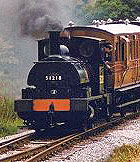 Mr D. N. Haselwood (deputy coroner) held an
inquest on the circumstances of the case at the Whalley Reading Room on Monday
afternoon (31st.
December) Mr. F. B. Cooper (solicitors
dept. of the L & Y R Co. Manchester), Mr R. S. Davies (Permanent Way Dept.
Blackburn) & Mr. Fenton (station master, Whalley) were present.
Mr D. N. Haselwood (deputy coroner) held an
inquest on the circumstances of the case at the Whalley Reading Room on Monday
afternoon (31st.
December) Mr. F. B. Cooper (solicitors
dept. of the L & Y R Co. Manchester), Mr R. S. Davies (Permanent Way Dept.
Blackburn) & Mr. Fenton (station master, Whalley) were present.
Henry Gooderham, weaver, son of the deceased, who was first witness to be called, said his father was a foreman platelayer in the employ of L&Y Railway company and was 56 years of age. He left home about 6:45 am on the Friday morning last to go to work, was then quite well and was brought home dead about one o'clock the following morning. Deceased was a steady man.
Henry Singleton, 12 Highfield Rd, Blackburn, engine
driver on the employ of Lancashire & Yorkshire Railway Company. On Friday he was
driving the 8:40 goods train from Blackburn to Chatburn. Witness saw the
deceased about 4 o'clock, half a mile from Whalley station while taking his
engine to Clitheroe for water. Deceased was then walking on the outside sleeper
ends of the up line in the direction of Whalley, and witness motioned to him &
deceased responded. It was then getting dark but there was sufficient light to
see & recognised deceased. That was the last occasion witness saw deceased
alive.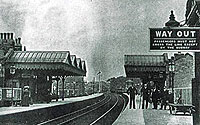
John Rushton (P.C.) Whalley, said at 12:45 on Saturday morning he received information that deceased had been run over on the line between Whalley & Clitheroe, and he procured a stretcher & conveyed the body from the station home. Deceased had evidently been knocked down by a passing train, and had received serious injuries. He had a deep punctured wound on the right eye, the right hand, part of the right forearm and right leg were cut off and there were also three or four long wounds to the head.
Henry Gooderham recalled, said when his father did not return home as usual on Friday night he went to the station to make enquires and proceeded along the line with a man named Exton in search (was this Thomas Exton, the father and probable friend of George. He would have been a relatively old man at 62 & with a snow storm blowing, it could have been William Exton, aged 27 & a workmate of Henry's) About 11:30pm they found the body laid in four foot of the down line about two & a quarter miles from Whalley. The body was then quite lifeless & cold.
The Deputy Coroner said it was evident the man had been looking the line as was his duty and had failed to notice the approach of a passing train and was run over & accidently killed while following his employment.
The jury returned a verdict of "accidental death".
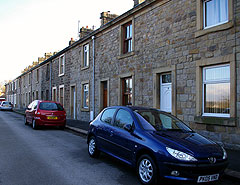 Difference
in address. Did George move after 1901 into house number 4 after at least ten years
at number 8? All Bank cottages are on one side of the street and the terraced
houses are numbered 1-20. On the 1901 census they were all noted as being four roomed houses. He had fewer children to get into the house by 1906 but as they appear to
be the same size cottages, I think the newspaper may have got the house number wrong. The Exton
family were at
No. 6 Bank Cottages in 1901, so never far away even if he had moved.
Difference
in address. Did George move after 1901 into house number 4 after at least ten years
at number 8? All Bank cottages are on one side of the street and the terraced
houses are numbered 1-20. On the 1901 census they were all noted as being four roomed houses. He had fewer children to get into the house by 1906 but as they appear to
be the same size cottages, I think the newspaper may have got the house number wrong. The Exton
family were at
No. 6 Bank Cottages in 1901, so never far away even if he had moved.
His area of duty.
I think Primrose is an area in the south west of Clitheroe
but that is from a modern map.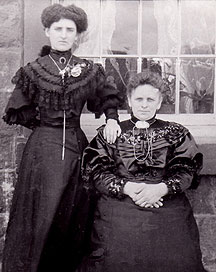
The location of his death. If he was seen by an engine driver within half a mile of Whalley station, heading towards Whalley on the opposite track at about 4 o'clock, but found two & a quarter miles from Whalley, it looks as if he crossed the track, (to check something?) and his body was actually carried by the train for some way.
It shows what another era is was. The style of writing in the newspaper, no easy way of communicating like today. No home phones, no mobiles nor cars. Everything was done at a walking pace. Did the family think he was in the pub getting a warming dram after a bitter day? Was Mary mad at him for ruining the tea she'd made?
How awful was it to find the broken & torn body of your father? Having to carry the battered body 2 miles to the station at Whalley & get the police out. You then had to carry him another mile, back up the hill to Bank cottages on the stretcher, to your mother & sister to lay him out at home. There was no practise of laying out in a funeral parlour then. It was all done from the home. I always believed local areas had their "laying out" women who did it as a service.
In the December two years later, my grand mother, Nellie Gooderham had married Billy Hebden. They called their first child Robert George Alfred & in 1911 my mother, Florence was born. On the census return of 1911, great grandma Mary Gooderham had moved in with her daughter Eva & son-in-law Oliver Exton at 131 Church St in Gt. Harwood. She lived until 1917, making her 65.
It is unfortunate that I don't have a photograph of George. There will be one out there somewhere. Will the magic of the inter-web thingy find some one on a Gooderham search & we can complete this page!
Links to genealogy
The Lancashire & Yorkshire Railway site.
Billington & Whalley excellent Railway history
